Reptiles and Amphibians
Heathlands are the most important areas in the UK for reptiles. The heaths provide warm, open areas for basking and egg laying and are a great source of invertebrate food. Amphibians make their home in damper areas and need open water to lay their eggs in.
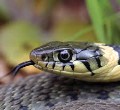 Grass snake, sometimes called the ringed snake or water snake is a Eurasian non-venomous snake.
Grass snake, sometimes called the ringed snake or water snake is a Eurasian non-venomous snake. They have a distinct yellow/cream/white and black collar around neck and a round pupil.
The Grass Snake is the largest indigenous reptile in the UK, typically males reach 100 cm, females up to130 cm, though larger individuals have been recorded. Feeding is almost exclusively on amphibians, some individuals may take small fish.
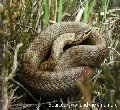 Smooth snakes kill their prey of lizards or small mammals by constricting them in coils of its body. They live among mature heather plants and bask in the sun entwined in the stems. Smooth snakes are the UK’s rarest reptile and are mainly found on heathlands in Hampshire, Surrey and Dorset.
Smooth snakes kill their prey of lizards or small mammals by constricting them in coils of its body. They live among mature heather plants and bask in the sun entwined in the stems. Smooth snakes are the UK’s rarest reptile and are mainly found on heathlands in Hampshire, Surrey and Dorset.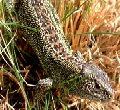 Sand lizards are so-called because they rely upon the sandy conditions found on heathlands or sand dunes. They lay their eggs in patches of bare sand where they are able to develop in the warmth. During the breeding season, April and May, the males have bright green flanks to attract a mate.
Sand lizards are so-called because they rely upon the sandy conditions found on heathlands or sand dunes. They lay their eggs in patches of bare sand where they are able to develop in the warmth. During the breeding season, April and May, the males have bright green flanks to attract a mate.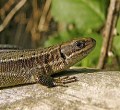 Typically an adult Common lizard is 15cm long nose to tail. Usually a shade of brown, but variations include yellow, green and black. They feed on worms, slugs and insects and give their prey a good shake, to stun it, before swallowing. Common lizards hibernate, often in groups, amongst rocks or dead wood generally between November and March.
Typically an adult Common lizard is 15cm long nose to tail. Usually a shade of brown, but variations include yellow, green and black. They feed on worms, slugs and insects and give their prey a good shake, to stun it, before swallowing. Common lizards hibernate, often in groups, amongst rocks or dead wood generally between November and March.Adult lizards emerge from their hibernation sites in early spring. Mating takes place around April.
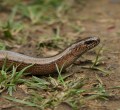 Slow worms
are lizards, although they have lost their limbs completely and are
often mistaken for snakes. Slow worms typically grow to between 40 and
50 cm (16 and 20 in), with the females slightly larger than the males.
Slow worms
are lizards, although they have lost their limbs completely and are
often mistaken for snakes. Slow worms typically grow to between 40 and
50 cm (16 and 20 in), with the females slightly larger than the males.They hibernate from October to February/March, both communally and solitarily, and sometimes share hibernating sites with other reptiles.
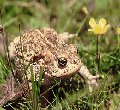 Natterjack toads are smaller than common
toads with shorter legs, and have a distinctive yellow stripe along
their back. They require warm, shallow pools in which to lay their
strings of eggs and sandy banks in which to burrow over winter. They
hunt prey on short turf or bare ground.
Natterjack toads are smaller than common
toads with shorter legs, and have a distinctive yellow stripe along
their back. They require warm, shallow pools in which to lay their
strings of eggs and sandy banks in which to burrow over winter. They
hunt prey on short turf or bare ground.